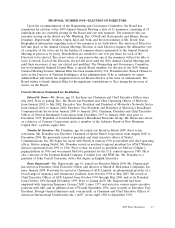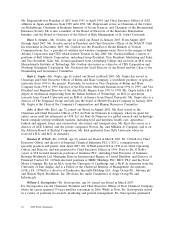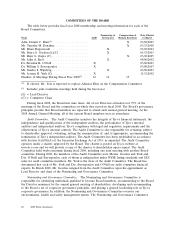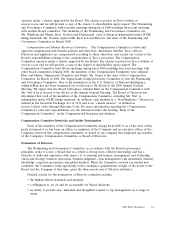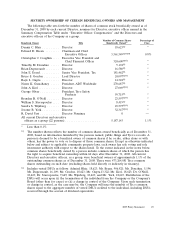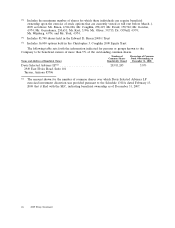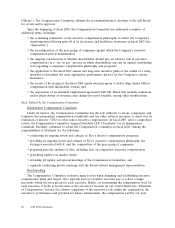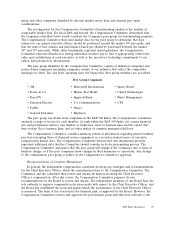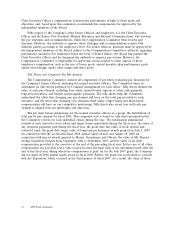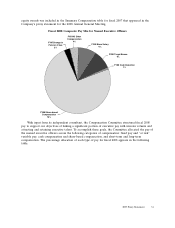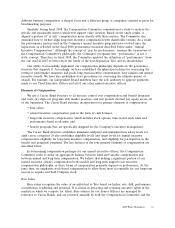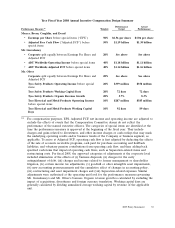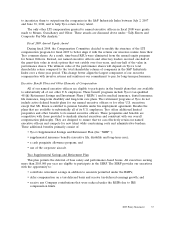ADT 2008 Annual Report Download - page 44
Download and view the complete annual report
Please find page 44 of the 2008 ADT annual report below. You can navigate through the pages in the report by either clicking on the pages listed below, or by using the keyword search tool below to find specific information within the annual report.EXECUTIVE OFFICER COMPENSATION
Compensation Discussion and Analysis
Introduction
The Compensation Discussion and Analysis section of this proxy discusses the role of the
Compensation and Human Resources Committee (the ‘‘Compensation Committee’’) in establishing the
objectives of the Company’s executive compensation plans; the Compensation Committee’s executive
compensation philosophy, and the application of this philosophy to Tyco’s executive compensation
plans. It also provides an analysis of the compensation design, and the decisions the Compensation
Committee made in fiscal 2008 with respect to the five ‘‘named executive officers’’ of Tyco: Edward D.
Breen, the Chairman and Chief Executive Officer; Christopher J. Coughlin, the Executive Vice
President and Chief Financial Officer; George R. Oliver, President, Safety Products and Electrical &
Metal Products; John E. Evard, Senior Vice President and Chief Tax Officer; and Naren K.
Gursahaney, President, ADT Worldwide.
In designing the Company’s executive compensation program, the Compensation Committee
focuses on reinforcing both the Company’s business objectives and its efforts to create shareholder
value. It is guided by a philosophy which holds that our executive compensation program must
(i) provide for performance-based reward opportunities that support our business objectives; (ii) align
payouts with the attainment of those objectives; (iii) reward superior long-term performance by linking
a significant portion of each executive’s total pay opportunity to sustained shareholder returns;
(iv) attract, retain and motivate key executives by providing appropriate levels of fixed and variable
compensation, short-term and long-term incentives, and cash-based and stock-based pay; (v) offer those
most accountable for our long-term performance the opportunity to acquire and hold a significant
amount of Tyco equity; and (vi) recognize and support outstanding individual performance and
behaviors that support our core values—Integrity, Excellence, Teamwork and Accountability.
Role of the Compensation Committee
The Compensation Committee consists exclusively of independent directors, who are also ‘‘outside
directors’’ as defined in Section 162(m) of the Internal Revenue Code.
Under the Company’s governance structure and the Compensation Committee’s charter, the
Compensation Committee is responsible for:
• reviewing and approving the Company’s compensation, benefits, Human Resources policies and
objectives;
• determining whether the Company’s officers, directors and employees are compensated in
accordance with those policies and objectives; and
• fulfilling the Board’s responsibilities relating to compensation of the Company’s executives.
In executing its responsibilities, the Compensation Committee conducts six regularly-scheduled
meetings, plus additional meetings and conferences as appropriate. The Compensation Committee
relies on information and advice provided by its independent consultant and on information purchased
from other data providers. It also relies on the support of the Company’s Human Resources
Department. The Compensation Committee benchmarks plan design and operation against the
executive compensation plans of a carefully chosen roster of companies that qualify (under the
Compensation Committee’s criteria) as competitors for similar business and executive talent.
Additionally, the Compensation Committee regularly reviews compensation-related tally sheets
prepared for certain key executives, including those who are considered ‘‘Section 16’’ officers for
purposes of reporting beneficial stock ownership under the Securities and Exchange Act of 1934. (Each
of these executives is referred to as a ‘‘Senior Officer’’; collectively, they are referred to as the ‘‘Senior
2009 Proxy Statement 27


